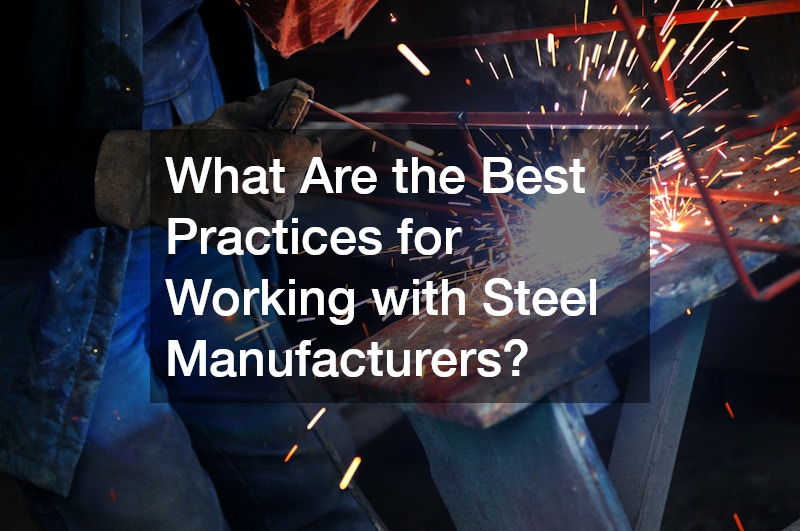What Are the Best Practices for Working with Steel Manufacturers?
When embarking on any construction or fabrication project, collaborating with reliable steel manufacturers is crucial to ensuring both structural integrity and project success. Whether you’re developing commercial infrastructure, residential builds or custom-designed steel components, effective communication and smart planning can save time, money and stress.
Here’s a guide to the best practices for working efficiently with steel manufacturers in Australia.
Start with Clear Project Specifications
Before engaging with any supplier, ensure your specifications are detailed and accurate. This includes the type of steel required (e.g., structural steel, stainless steel or galvanised steel), dimensions, grades, finishes and any treatments or certifications needed. The more specific your brief, the easier it will be for the manufacturer to provide accurate quotes and timelines.
In Australia, compliance with relevant standards such as AS/NZS 5131 (Structural Steel Fabrication and Erection) is a must. Including this in your documentation ensures everyone is on the same page from day one.
Choose the Right Manufacturer for the Job
Not all steel manufacturers are created equal. Some specialise in heavy industrial components, such as structural beams for large-scale infrastructure, while others may focus on lighter, architectural steelwork like staircases, balustrades or decorative features. Selecting the right manufacturer starts with understanding your project’s scope and complexity.
A quality supplier will not only offer the technical skills needed but will also have a proven ability to deliver on time and within budget. Look for businesses that can show a solid track record through detailed case studies, industry certifications or client testimonials — these offer real insight into their reliability and workmanship.
Communication is Key
Establish clear lines of communication from the outset. Assign a project contact or coordinator who can liaise directly with the steel manufacturer throughout each phase of the job. Make use of modern project management tools if necessary to track updates, revisions and deliveries.
A good steel manufacturer should be proactive, responsive, and transparent. Regular check-ins or progress reports can help catch issues early — especially on large or custom fabrication jobs. Don’t be afraid to ask for samples, mock-ups or drawings to ensure alignment on expectations.
Prioritise Quality and Compliance
Working with steel means there’s no room for shortcuts. Check that your steel manufacturer uses certified materials and adheres to best practices for welding, cutting and surface treatment. Certifications such as ISO 9001 (Quality Management) and ASI Steel Sustainability credentials are strong indicators of professional operation.
In Australia, safety and compliance are non-negotiable. Always ensure your manufacturer conducts routine quality checks and is willing to provide documentation to back up their standards. If your project involves structural steel, it’s essential that all fabricators and welders are certified accordingly.
Understand Lead Times and Logistics
Steel manufacturing isn’t always a quick process — particularly when custom components or specialty coatings are involved. Clarify lead times early and build some buffer into your schedule. Delays in material supply can have a domino effect on your wider project.
Discuss transportation and delivery options too. Will the steel arrive pre-cut and ready to install? Will cranes or handling equipment be needed on-site? Who’s responsible for unloading and inspecting the materials on arrival?
Being proactive about logistics helps reduce costly downtime and avoids unnecessary surprises.
Foster a Long-Term Relationship
If you’re in the building, fabrication or infrastructure space, chances are you’ll need steel solutions again in the future. Building a strong relationship with a trustworthy manufacturer pays dividends over time. Reliable partners are more likely to prioritise your work, offer competitive pricing and share valuable insights to improve your project outcomes.
Give feedback, acknowledge good service and pay on time — it’s basic business etiquette but it strengthens your reputation in the industry and ensures smoother collaborations in future.
Final Thoughts
In the construction and manufacturing world, steel remains a cornerstone of durability, design and efficiency. But to unlock its full potential, working with steel manufacturers needs to be approached with care and strategy. From clearly defined specs to open communication and quality assurance, each step plays a role in delivering a successful outcome.
So whether you’re designing a steel-framed warehouse, installing decorative balustrades or fabricating complex commercial components, following these best practices will help ensure your project stays strong — from blueprint to build.


Post Comment